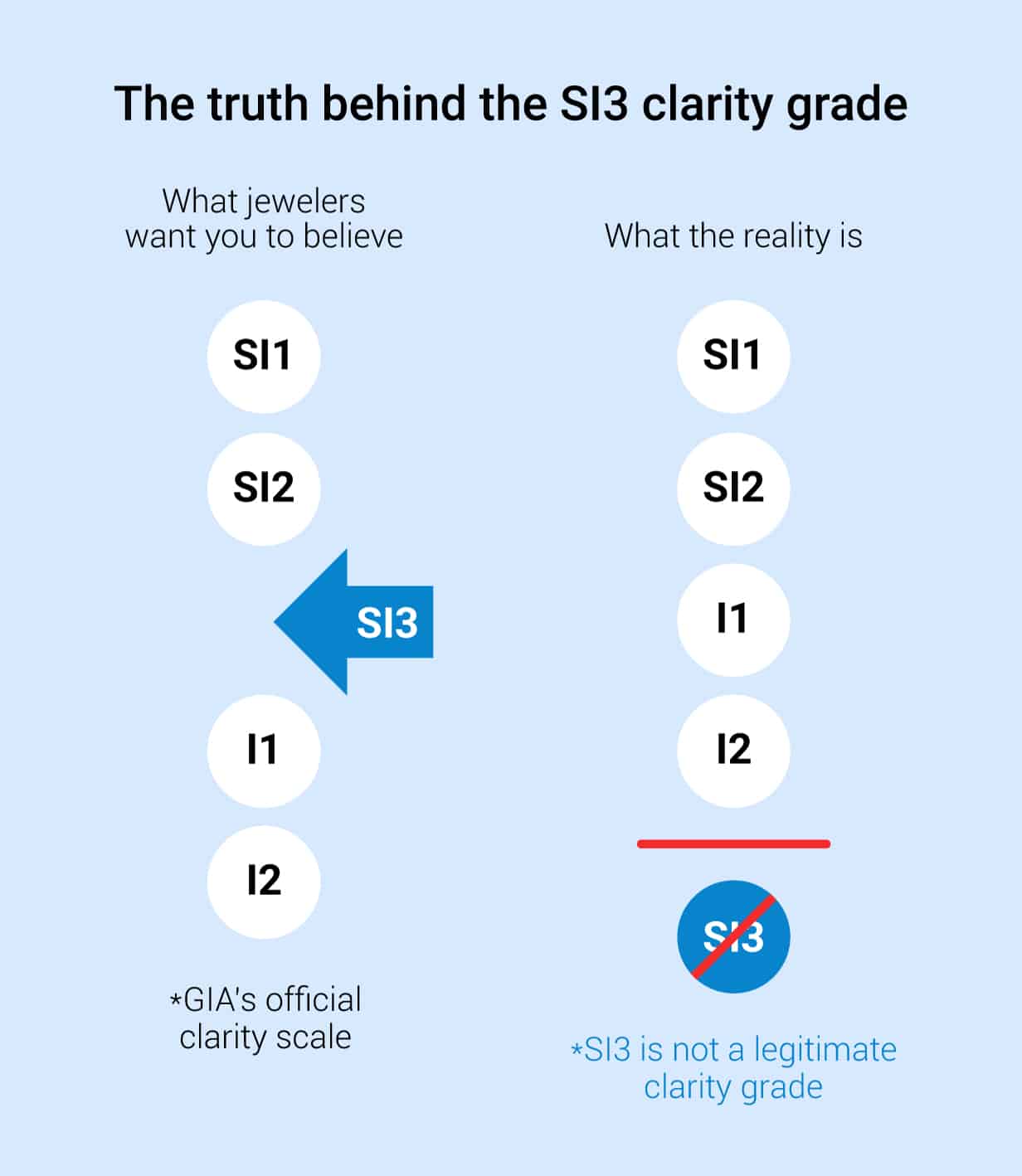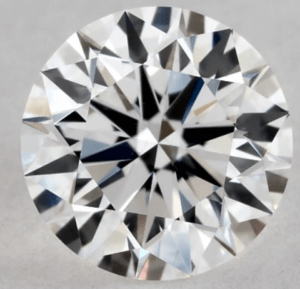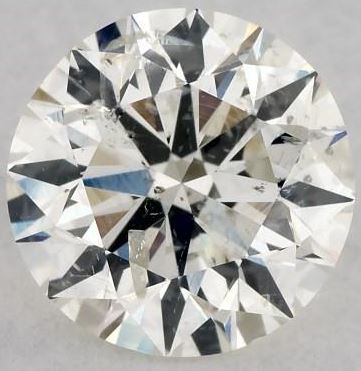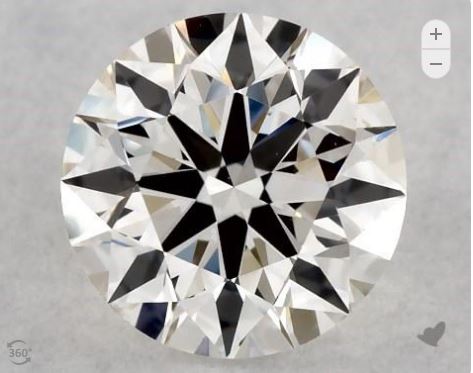A Guide to SI3 Clarity Grade Diamonds
Why you should never consider an SI3 clarity grade diamond
Why you should never consider an SI3 clarity grade diamond
SI3 is a diamond clarity rating used by some labs to indicate a clarity that falls between the Slightly Included and Included ranges. It is important to note that the GIA does not have an SI3 rating and it is our expert opinion that you should avoid these diamonds. These diamonds are almost always diamonds that have been given an I1 or worse rating by the GIA and then submitted to another lab with lower standards and “upgraded” to an SI3. An SI3-rated diamond will, in all likelihood, not be eye-clean and will contain obvious blemishes visible to the naked eye. We don’t consider these diamonds to be a good value for your money.
We strongly encourage all readers to steer clear of diamonds with a clarity grade of SI3. The SI3 grade is used by lab entities that are not reliable—and you’ll likely get a diamond with less beauty and value than what you paid. This is what they are doing. They are taking ugly I1 clarity diamonds like this one from James Allen, and using a sketchier lab to give it an “SI3” grade which seems nicer. It is nothing more than parlor tricks.
As the GIA explains below:
“Some diamond grading labs issue a clarity grade of SI3. GIA does not. The Institute has studied the SI3 suggestion at various times over the years. GIA still concludes there is no reason to change its long-standing and universally accepted diamond grading system.” Gemological Institute of America (GIA)
In other words, this isn’t a clarity grade that’s used by reputable lab entities. As such, we do not suggest considering any diamond that’s marketed as having “SI3” clarity.
We instead recommend looking for a diamond with a GIA certificate. For most diamonds, we suggest a VS1 calrity or VS2 clarity gradesfor excellent value. You can also find great SI1 or SI2 diamonds as long as you have high-quality videos or photographs to inspect. At these levels, blemishes and inclusions can’t be seen with the naked eye, but cost far less than VVS, IF and FL diamonds. This VS2 round cut diamond from James Allen, for example, is beautiful and eye clean.
Above all, ensure that your diamond is eye clean of blemishes and inclusions. Look closely at any diamond before making a purchase. To make it easier, choose a vendor with high-quality photography like James Allen or Blue Nile.
If you have questions or want assistance in searching for a truly stunning diamond, contact our experts.
What is SI3 clarity?
Why should you avoid Si3 clarity diamonds
What should you look for instead of SI3 clarity?
What are eye-clean diamonds?
Where to buy eye-clean diamonds?
Why you should trust us
You may come across SI3 diamonds in your search for the perfect stone. While a diamond with an SI3 clarity grading can seem like a good deal, that’s almost never the case.

This is how companies try to trick you. They will take a horrific diamond like this from James Allen, get it recertified by a less legitimate lab and call it an “SI3”. The salesperson may even be devious and say “This is an SI diamond” which, while devious and misleading, is now technically correct. In reality, though, you are better off spending your money on a diamond like this also from James Allen.
The SI3 grade is meant to help differentiate the better I1 diamonds from other diamonds with slightly more inclusions (i.e. the worse I1 diamonds). The grade was created by EGL lab in the 1990’s. On the EGL scale, SI3 clarity sits between the I1 and SI2 grades. The idea behind this additional grade is that there are some I1 clarity diamonds that, despite their low clarity grade, are still beautiful diamonds. While this is true, it doesn’t mean a new clarity grade is necessary.
Additionally, the only grading companies that use SI3 are the ones that are not reliable or reputable, like EGL. The EGL has a bad reputation when it comes to quality claims, which can mislead customers to buying diamonds that aren’t as beautiful or valuable as they report.
Even if there are some “nice I1s” that warrant a special designation, you won’t find them with an EGL certificate. If a diamond carries an SI3 grade, it’s of lower quality than the “nice I1s” from GIA. The SI3 grade is primarily used to trick potential buyers into a diamond that is less than stellar.


For example, if you were to bring an EGL-graded SI3 diamond to GIA, the diamond would probably be graded worse by the GIA. Reputable labs like GIA don’t recognize the SI3 grade, and neither should the consumer.
The GIA grade for clarity (which is considered the standard in the diamond industry) is:
Other reliable grading entities use similar clarity scales. For example, the American Gem Society (AGS) uses a numerical scale that corresponds to the grading system used by the GIA.
Many consumers believe that any diamond graded lower than SI (Small Inclusions) is undesirable. For instance, I1 and I2 diamonds often have noticeable inclusions and are not eye clean—making them less than stellar choices. By giving a diamond an SI3 grade, it’s a step above an I1, making the diamond seem more appealing to customers.
The SI3 grading, however, distorts the line between I1 diamonds and SI2 diamonds. With an SI3 diamond, a jeweler can make an inferior I1 (Included) diamond seem like an SI (Slightly Included) diamond.
A weakly graded EGL diamond—like one with an SI3 grade—can confuse a customer. It gets them interested in an less than desirable diamond. Rather than choosing a stunning diamond like this one from James Allen within your price range, you’re paying for something that’s falsely advertised.
Jewelers utilize the SI3 clarity grade to sell more diamonds, even if the customer doesn’t get the actual beauty and value of what they’re paying for. That’s why we encourage all readers to steer clear of SI3 diamonds. We don’t want you to get tricked or scammed.
If you have questions about diamond clarity or overall quality, feel free to reach out to our experts.
We’ll start by saying that you should only look for diamonds that are certified by either the GIA. This lab is the most reliable and respected entity in the diamond world. By choosing a diamond with this certificate, you ensure you’re getting the quality that the report claims.
For clarity, we generally recommend looking for VS1 to SI2 diamonds. VS1 and VS2 diamonds usually appear eye clean, meaning no blemishes or inclusions can be seen by the naked eye. SI1 and SI2 diamonds can be eye-clean as well but need closer inspection.
Below is an example of an eye-clean VS2 diamond:

While the higher grades, like VVS1 and VVS2, may seem better, a VVS1 diamond will probably look just as eye clean as a VS1 diamond. For example, this stunning VS2 diamond from James Allen appears clean to the naked eye and costs $3,229 per carat. This beautiful VVS2 diamond from James Allen also looks clean to the naked eye, but costs $5,278 per carat. With all other traits being similar, you’ll save plenty of money by choosing a Very Slightly Included (VS1 or VS2) diamond instead of a Very Very Slightly Included (VVS) diamond.
In some instances, there are I1 diamonds that are eye clean, here’s an example from James Allen, or have blemishes that’ll be covered by a metal setting. For example, if a diamond has an inclusion near the perimeter, like in this I1 diamond from James Allen, it can be set in a ring or necklace to mask the imperfection. I1 diamonds with minimal imperfections are rare though, so we suggest bumping up to an VS1 or VS2 grade.
While this article addresses the technical grading and value of SI3 clarity diamonds, that is not what we recommend focusing on when purchasing a diamond. In our opinion, a consumer’s goal should be to find the cheapest (in regards to clarity; other factors matter as well) “eye-clean” diamond you can find. We use “eye-clean” to describe diamonds that may have inclusions if you look at them with a magnifying glass (or microscope or loupe), but the typical person can’t see the inclusion with their naked eye.
We have recently developed Ringo, a patented artificial intelligence model, that can examine videos of diamonds and determine if they are eye-clean. Ringo will also filter for other parameters like making sure the diamond is well-cut, doesn’t have fluorescence issues and will match the style setting you choose.
If you want to select a diamond specifically for your personal needs (budget, shape and setting style), check it out here.
When it comes to evaluating a diamond for its clarity, it’s best to review the diamond closely yourself. Purchasing a diamond online usually allows you to find the best deal. Choose an online vendor with high-quality photography, so you can see for yourself what the diamond truly looks like.
Throughout our many years of experience, we’ve thoroughly vetted a number of diamond vendors. The recommended vendors below have provided thousands of our readers with beautiful, eye-clean diamonds.
James Allen offers the best online photography in the diamond industry, allowing you to look closely at each stone before purchase. They also provide appealing prices and high-quality certification (GIA & AGS) on all diamonds.
Blue Nile maintains the largest online inventory of diamonds and settings. They emphasize both diamond and jewelry quality. All diamonds come with high-quality certification (GIA).
Brian Gavin presents super-ideal cuts with the “Brian Gavin Signature” Hearts & Arrows collection. All diamonds come with high-quality certification (GIA & AGS).
We strongly suggest avoiding SI3 diamonds altogether. With an SI3 diamond, you’re paying far more than what you should for something that only appears better on paper.
Choose a diamond with a GIA certificate, and look for diamonds in the clarity range of VS1-VS2.
If you have questions about finding a stunning diamond within your price range, please reach out to us and we’ll begin with your complimentary search.




Before you buy a diamond, get personal buying advice from industry veterans. We'll help you get the best diamond for the money.
DISCLAIMER: We don't use your email for marketing. Period.
A diamonds’ price is determined primarily by the 4 Cs of the diamond. On the wholesale level, diamond prices are first based on a diamond shape and
Buying an engagement ring is often one of the first major purchases in a person's life. The process can be fraught with tension as there are so m
A wide range of 1 carat diamonds exist both in online markets and local diamond jewelry stores. Not only are there significant differences in beauty
Please enter your email address to receive your 25% off coupon code:
Here is your coupon code: GFDSF3GF